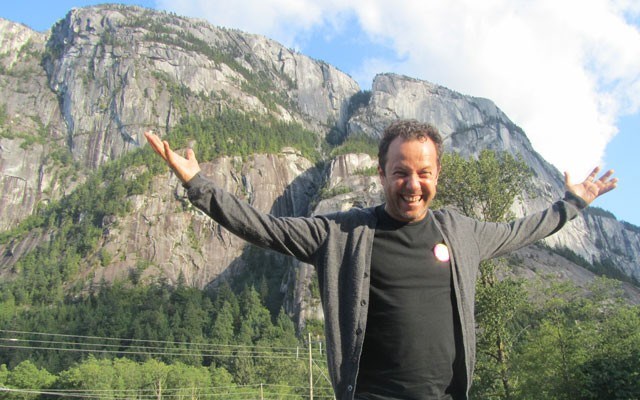In the early 1980s, young Brazilian Vik Muniz, who was living a modest life in a favela in Sao Paulo, was shot in the leg during a fight he was trying to break up.
It turned out his assailant came from a wealthy family and was made to pay reparations to Muniz. With that money he flew to New York City to become an artist.
He arrived in 1983 and never looked back, working first as a sculptor and then moving into photography — a medium that has taken him to the top rank of the art world. Individual pieces by Muniz sell for tens of thousands of dollars and are part of modern collections around the world.
On Monday, July 21, Muniz came to Squamish to create a new conceptual public artwork as part of the Vancouver Biennale. The piece is being constructed along the Mamquam Blind Channel downtown, and Muniz hopes the public will take part in its creation.
"This whole area, including Vancouver, you have city and nature together. It is very interesting. There are not that many places with this," Muniz says, gesturing to the Stawamus Chief Mountain.
"I am very impressed with the amount of art that I have seen outside from Vancouver to here. Also, there is something in being in a place that inspires you to be outside. You have so much beauty."
A public welcome on Tuesday hosted by the Squamish Nation at Totem Hall on the Stawamus Reserve was followed by a screening of a documentary about a three-year project carried out by Muniz in the world's largest landfill, Jardim Gramacho in Rio de Janeiro.
Oscar-nominated Waste Land, directed by Whistler Film Festival award-winning director Lucy Walker (The Crash Reel), followed Muniz at work with pickers of recyclable garbage. He used refuse to create mosaic portraits of the workers, raising $250,000 to help them from the sale of the works.
Muniz says his Squamish project will differ from his Waste Land project, though his Facebook page says it will be a giant portrait.
"It will be different. In the case of Waste Land it was a case of doing an art project with people who have absolutely no contact with art, using materials that were not artistic in any sense and trying to come up with something inspiring with the feel of art at the end," he says.
"But what will be similar is the idea of creating a project which has inclusion and participation.
"I just did this in Brazil, in an art project for children. Children don't want to look at stuff; they want to play with it. We created an environment in which you walk and kids can make a drawing with a Crayola. It would get scanned and when they got to the centre room (of the show) it is projected on the floor and they can redo that drawing with fabrics, sticks, rope — all colourful stuff. And there is a camera that captures them."
Muniz says it was such a success that people would line up for hours in order to take part.
"Museums are places of contemplation or meditation. But actually, in the middle of that, I do that work to be involved with projects that have a direct relationship with the public. That is very interesting for me and I think it is interesting for the public, too. To participate. It's about action, rather than contemplation."
As an artist, Muniz says this means he may not have control over the final outcome of his project, but it is something he is willing to do because of the importance of the process.
"I don't end up with something that I want, but I end up with something much bigger that reflects not only my vision of it, but also a collective vision," he says.
Muniz is keen to make visual art accessible to all, but recognizes there is often a threshold that the public fear to cross.
"People don't always go into galleries or museums. My parents, for instance, felt threatened by it. They didn't know what they'd find inside. If they were used to seeing art outside on the street as part of their lives they would feel they could. A museum is a place where you ritualize your visual experiences and they are very important, but it is also important that there is a sort of permeability. It needs to be welcoming," he says.
Barrie Mowatt, founder and president of the Vancouver Biennale, concurs.
"Vik talks about 'an open air museum' and that's what the Vancouver Biennale is all about. It's about the environment, about engaging people where they work, play and transit. It is taking art of the highest level to the people," Mowatt says.
Muniz is here for five days, and his team will continue on the piece in his absence, completing it by Aug. 8. Those wanting to take part can contact Squamish organizer Krisztina Egyed at krisztinakegyed@gmail.com or milena@vancouverbiennale.com.
Along with Muniz, Squamish is currently hosting three young international artists as part of the Vancouver Biennale's residency program: Sumakshi Singh and Shweta Bhattad of India, and Hasan Hujairi of Bahrain. Twenty-six international artists-in-residence will spend a month to six weeks in Squamish during the biennale, which ends in 2016.
For more information visit: www.vancouverbiennale.com.




